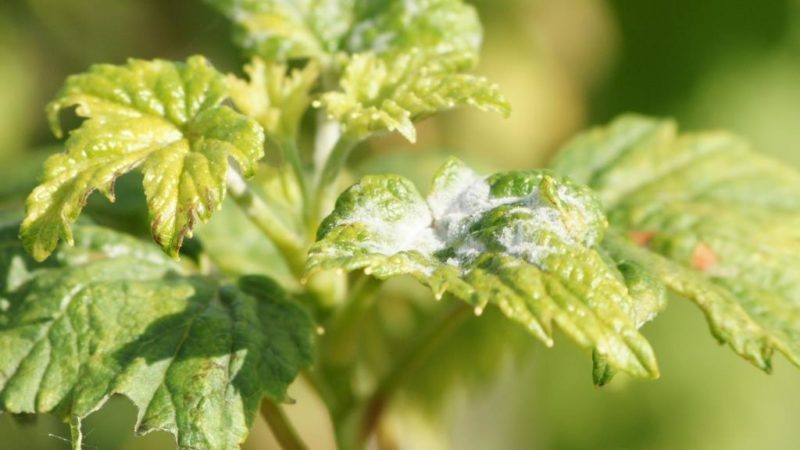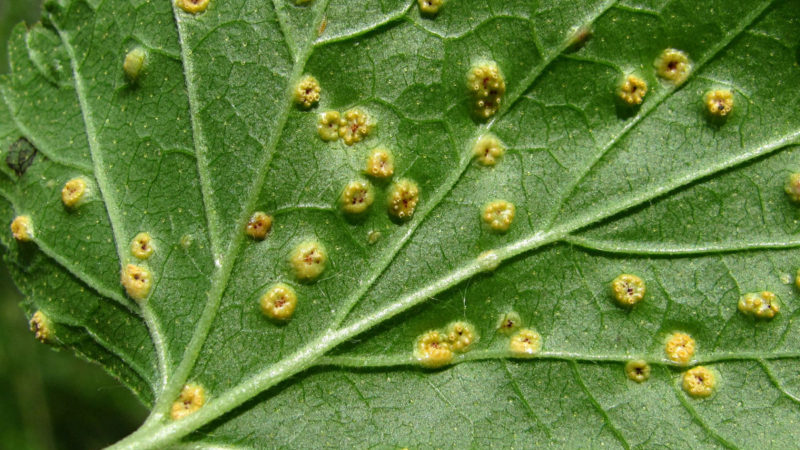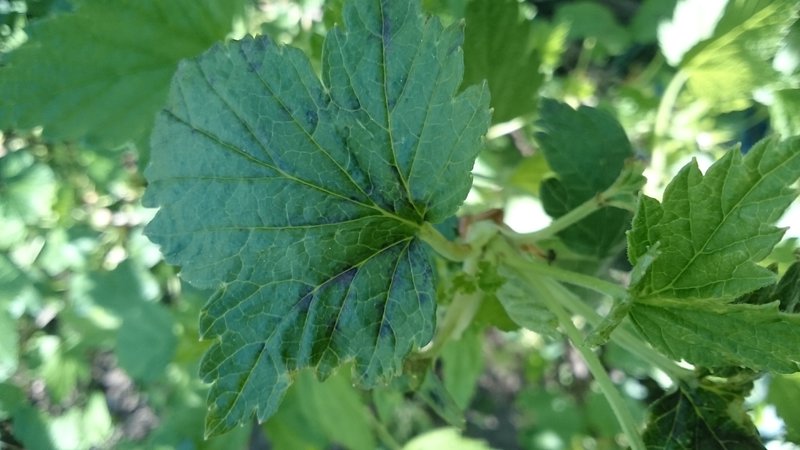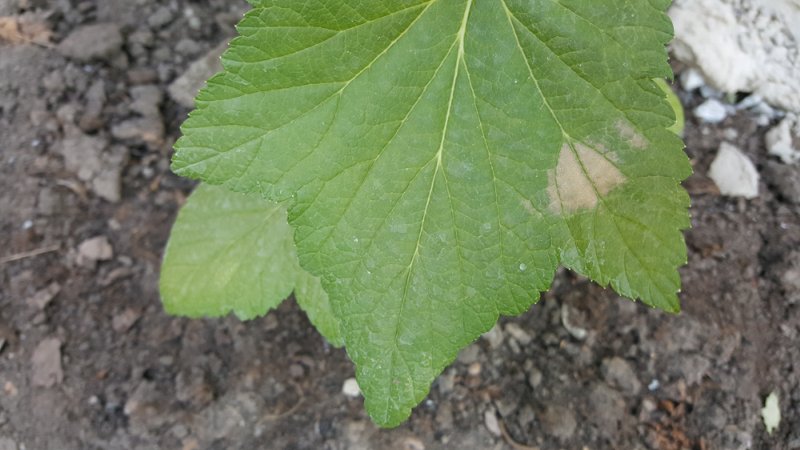Diseases and pests of currants, ways to combat them, preventive measures
In Russia, there are 4 types of currants (white, black, yellow and red). Although they differ in color, flavor and aroma of berries, the plants are unpretentious and have similar care requirements. They are affected by the same diseases and pests.
Infections and insects become the main cause of death of fruit and berry bushes. In the presence of concomitant factors, even varieties with strong immunity are affected. Without timely treatment, not only the infected plant will die, but also the crops next to it. To save the garden, it is important to recognize diseases and pests in a timely manner, and to know methods of dealing with them.
The content of the article
Diseases and their treatment
A healthy currant has many bright green large leaves of the correct shape, gives a rich harvest of round berries with a rich taste, easily tolerates winter. The infected plant loses its frost resistance, yields poor yields, and loses greenery. Photosynthesis deteriorates, as a result, the currant dies.
Many diseases are effectively treated in the initial stages. It is more difficult to deal with them later. Therefore, it is important to detect the infection as early as possible. The following signs should alert the gardener:
- suspicious spots on the leaves;
- plaque on greenery, fruits and shoots;
- yellowing of leaves and falling off before the autumn period;
- drying out of the bush;
- falling of fruits;
- the appearance of convex formations.
To understand why currants are sick and what to do, it is important to compare the existing symptoms with signs of disease.

Tuberculariosis
Tuberculariosis is a fungal disease that leads to the drying out of the branches and leaves of a plant. The development of the disease is facilitated by a high level of moisture and mechanical damage to the bushes.
The infection manifests itself as follows:
- red tubercles form on young shoots;
- the infection spreads to other branches and enters the bark, forming red lumps;
- already in July, the leaves dry up, curl and fall off;
- the affected branches die.
To get rid of tuberculariosis, diseased branches are removed. Places of cuts are sprinkled with ash and greased with garden varnish. The bush is sprayed with preparations containing copper.
Anthracnose
Anthracnose is a fungal disease. The plant becomes infected with it in the spring, but the first signs appear after 1.5–2 months, in the summer. The epidemic usually occurs in July.
The affected plant quickly loses leaves and fruits. Its winter hardiness decreases, photosynthesis worsens.
Important! The fungus is not afraid of frost and hibernates in plant debris. It is activated during prolonged rains, with excessively abundant watering, the presence of a large number of weeds next to the currants.
Signs of anthracnose:
- on the leaves of currant, first red or brown spots are formed, then swelling;
- gradually, the affected areas expand and merge into one large burgundy blister;
- the leaves dry up and fall off.
It is easiest to treat bladder disease in the initial stages. All affected greens are cut off. Healthy leaves are sprayed with one of the following preparations:
- Bordeaux liquid made from 100 g of the product and 10 liters of water.
- Folk: dissolve 1 kg of ash and 1 piece of laundry soap in a bucket of water.
- Chemical when other methods are powerless. One of the most effective means is "Alirin-B" (for 1 liter of water 2 tablets).
Processing is carried out 1 time in 7 days, in dry weather.
All types of currants are ill with anthracnose, but most often the infection affects the red one.
Septoriasis
Septoria, or white spot, is considered a disease of black currant but affects other plants as well. It is caused by a fungus that is activated in summer.
The causes of the development of the disease are thickening of the planting, high humidity, lack of sunlight, poor air exchange.
Recognize white spot by the following features:
- angular brown spots with a diameter of 2-3 mm are formed on the leaves;
- over time, they turn white with a dark border;
- the disease spreads to the fetus;
- affected leaves and berries fall off.
Before treating the disease, all the affected parts of the bushes are cut off, the weeds are carefully weeded. All collected vegetation is burned.
For the treatment of septoria, the following are effective:
- Bordeaux liquid (100 g of the drug per 10 liters of water);
- fungicides: phthalan, "Kuprozan", "Captan".
It is interesting:
Sclerotinosis
Sclerotinosis, or white rot, is a fungal infection that affects all parts of the plant and leads to the death of the bush. The fungus lives in the soil, is activated at high humidity and weakening of plant immunity.
Signs of white rot:
- brown weeping formations appear at the base of the shoots;
- leaves wither;
- spots begin to rot, a white bloom appears, resembling cotton wool;
- parts of the currants over the infected areas die off.
When the first symptoms are detected, the affected parts of the bushes are removed, the cut sites are treated with garden varnish. The entire shrub is sprayed with fungicides. If signs of the disease appear again, the affected plant is dug up and burned.
Important! If the diseased plant is not removed, the infection will spread to neighboring shrubs.
Powdery mildew

Powdery mildew - another fungal disease. The fungus is most active in the middle of summer.
The disease is dangerous for the plant: it affects all parts of the shrub, causing the leaves and fruits to fall off, and the shoots to dry out. Photosynthesis is impaired, and the chances of the plant surviving winter frosts are reduced. For several years, the culture completely stops growth and dies.
The reasons for the development of powdery mildew are dry soil, high air humidity, oversaturation of the soil with nitrogen. Currants are infected through the ground, infected planting material and weeds.
Signs of the disease:
- a dry translucent whitish bloom forms on the leaves and shoots;
- over time, it becomes denser, turns brown in places, resembles felt to the touch;
- affected shoots are deformed, stop growing and die off;
- berries are covered with bloom, darken, fall off without ripening.
The sooner treatment is started, the higher the likelihood of dispensing with serious chemicals. Before spraying the plants with special preparations, all diseased parts are cut off.
Treatment methods:
- Copper preparations. Currants are sprayed with Bordeaux liquid or copper sulfate.
- Folk method. Take 1 bottle of 5% iodine and 2 liters of milk on a bucket of water. Plants are treated 2 times with a break of 4 days.
- The bacterial method. Chicken manure is diluted with water in a ratio of 1:10. The resulting composition is sprayed on the bushes.
- Purchased substances. If folk remedies and preparations with copper do not help, use fungicides - "Topaz" or "Fundazol". In this case, the fruits cannot be eaten.
Rust

The causative agent of rust is a fungus. Usually the plant becomes infected in the middle of summer or autumn. As a result, leaves and berries fall off.
Important! Spores of sedge fungus, conifers, weeds are transferred.
There are two types of currant rust - goblet and columnar. The first is expressed like this:
- orange spots appear on the inside of the leaves;
- over time, they transform into yellow bubbles filled with spores;
- the affected areas increase and lead to the drying out of the entire leaf plate;
- leaves and berries fall off.
Columnar rust is no less dangerous. Its manifestations:
- the outer side of the leaves is covered with small yellow dots;
- red growths with spores are formed on the seamy side;
- the growths take the form of hairs, the leaves resemble felt to the touch.
All diseased leaves are removed before treatment. For treatment are used:
- biological product "Fitosporin";
- Bordeaux liquid diluted with water in a ratio of 1: 100.
Striped mosaic
Currant mosaic is a viral disease that causes the leaves to dry out and fall off and lead to the death of the bush.
Main features:
- yellow-orange areas appear on the leaves;
- the lesions begin to dry out, spreading over the entire surface;
- leaves fall.
The mosaic cannot be cured. Affected plants are removed from the site. To prevent the disease, the bushes are treated with insecticides, since they carry the pathogen of aphids and ticks.

Curly leaves
Both a virus and a fungus cause curliness. Both infections are spread by aphids. The signs are the same:
- leaves are irregular, with thicker areas;
- the leaf plate curls, bubbles and turns red;
- the leaves dry up and fall off.
To heal the plant, first get rid of the aphids and remove the damaged leaves. After that, the currants are sprayed with a solution of Bordeaux liquid.
Nectric drying of shoots
Nectric drying affects only red and white currants. The causative agent of the infection is a marsupial fungus. The disease leads to the drying out of young shoots, and then to the death of the entire plant.
Description of the symptoms of the disease:
- orange dots appear on young shoots;
- they grow in size and look bloated;
- the spores of the fungus ripen, and the formations turn black;
- young shoots die off.
To combat the disease, all affected branches are removed. The cut sites are treated with garden varnish, the plants are sprayed with a solution of Bordeaux liquid.
Reverse
Reversal, or terry, is a viral disease spread by a kidney mite. The disease leads to mutation of currants and infertility.
Reversal signs:
- leaves become more elongated, asymmetrical and smooth;
- they only have 3 blades instead of 5;
- the color of the greens changes to purple;
- flowers become longer and thinner;
- the currant ceases to exude its characteristic aroma;
- the ability to bear fruit is lost.
The disease is not cured. Affected bushes are removed from the site and burned. The site is quarantined for 5 years.
Chlorosis
Chlorosis is a disease caused by a decrease in the quality of photosynthesis and a lack of chlorophyll in the leaves of a plant. It occurs due to nutritional deficiencies and poor weather conditions. Expressed in:
- pale, yellowish greens;
- premature shedding of foliage;
- chopping shoots;
- dying off of roots.
To correct the situation, a complex mineral fertilizer is introduced, the care is adjusted.
Necrosis
Marginal necrosis causes excess chlorine in the soil. As a result, the edges of the leaves dry out, the greens become ash gray.
If signs of necrosis are detected, ammonium nitrate is added to the soil. This is done before and after flowering currants.
Pests and the fight against them

Pests are no less dangerous than diseases. They feed on juices, leaves and fruits, leading to the death of the shrub. Insects often carry viruses and fungi.
Currant pests:
- Kidney mite... It settles in plant buds and feeds on them. Affected kidneys appear swollen and rounded. The next year, small thin light leaves of irregular shape grow from them. The affected parts of the bush are cut off and burned. Currants are sprayed with preparations containing sulfur.
- Spider mite... Small light-colored insects feed on plant sap, covering the underside of leaves with cobwebs. The pest causes premature death and shedding of greenery.To get rid of spider mites, they use not only insecticides, but also folk remedies, for example, a decoction of wormwood with grated laundry soap. The currants are sprayed until the problem disappears completely.
- Sawfly. The larvae eat the pulp of the leaves, leaving only the veins. The pest resembles a green caterpillar with a black head and spots on its back, and has 10 pairs of legs. It hibernates in a brown glossy cocoon under the ground, in the spring it turns into a butterfly that lays eggs on the inside of the leaves. The larvae hatched from the eggs devour the greenery. The cycle is constantly repeating. To get rid of pests, an oilcloth is spread under the bush, on which the larvae are shaken off. If this does not help, use insecticides ("Iskra").
- Fire - a butterfly whose caterpillars feed on berries. Pests are green with black legs, head and stripes on the back. They envelop the ovaries with cobwebs, and then eat the berries, causing them to prematurely ripen and dry out. To get rid of the problem, pest nests are removed. The currants are treated with Karbofos before flowering.
- Moth. Another butterfly, whose caterpillars devour the leaves, leaving only the veins. To get rid of the pest, an oilcloth or cloth is spread under the bush and insects are shaken off on it. If that doesn't work, use insecticides.
- Glass-maker resembles a wasp with a thickening at the end of the abdomen. The insect lays the larvae under the bark. Caterpillars gnaw branches, leading to their death. The affected areas are removed by covering the cut sites with garden pitch. In addition, insecticides are used.
- Aphid. Small black insects feed on the sap of shoots and leaves. Because of this, the latter fall prematurely, the shoots stop developing, the bush dies. To get rid of the pest, the bush is sprayed with infusion of onion and garlic with laundry soap.
- Zlatka. Small shiny bugs settle in the shoots and eat them. The branches of a diseased currant die off. To save the plant, all affected parts are removed and insecticides are applied.
- Mole. Caterpillars eat currant buds, then turn into butterflies and lay their eggs in berries. The larvae eat the fruits from the inside. The pest hibernates in the lagging bark. Insecticides are used to combat.
- Shield. The larvae crawl along the tree and overgrow with a shield, under which they remain until the end of their life and lay eggs. The scale insects feed on plant sap, leading to the gradual drying of the branches and the death of the entire bush. To destroy the pest, the currants are sprayed with the "Rogor-S" preparation.
It is interesting:
How to get rid of spider mites on cucumbers in a greenhouse.
Why is black aphid on cucumbers dangerous and how to deal with the pest as efficiently as possible.
Gooseberry diseases and pests and methods of dealing with them.
Prevention of diseases and pests
Insect control, disease treatment and follow-up care for beginners is not as easy as it might seem. Therefore, it is much easier to prevent problems:
- Compliance with the rules of care (watering, loosening, mulching) is the basis of prevention. It is improper irrigation and the lack of loosening that become the main reason for the defeat of fungal infections.
- All old and diseased branches must be removed.
- When the snow melts, experienced gardeners "burn" the currants. To do this, the bush itself and the soil around it are watered with boiling water.
- Leaves and other vegetation around the bush are removed and burned in autumn. As the culture grows, the land around is weeded.
- In spring, currants, gooseberries and other fruit and berry bushes are treated with copper sulfate.
- It is advisable to choose varieties that are resistant to viral and fungal diseases.
- When planting currants, it is important not to thicken the planting.
- The soil, planting material and garden tools must be disinfected.
Conclusion
Diseases and pests are the most common cause of the death of currants.They affect all parts of the plant, leading to shedding of leaves, shedding of inflorescences and fruits, drying of shoots. It will be possible to get rid of the problem by timely recognizing the symptoms and choosing the right treatment. Recovered plants take a long time to recover and need increased care, so diseases are easier to prevent than to cure.